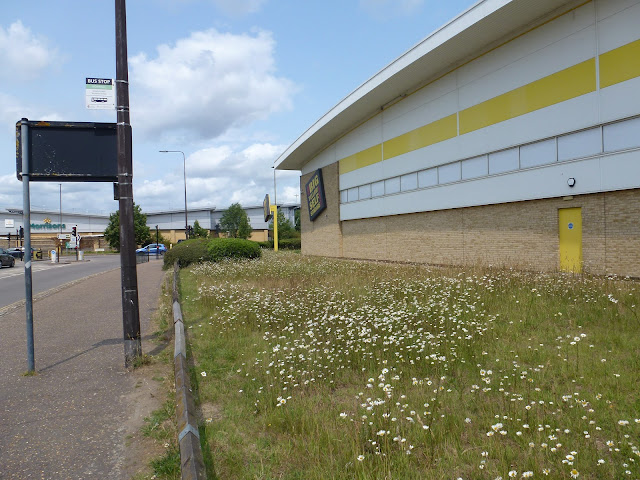First, the bad news. On my annual visit today (4 June) to Big Yellow Self Storage on Canary Way in central Norwich, the bee orchid count was zero. That’s the first time I’ve found none in 17 years of visits, since I first found a few flowering spikes in 2009.
I wasn’t surprised. Bee orchids are known to respond to weather conditions, and they will have stayed dormant in England’s driest spring for more than 100 years – see Met Office story via this link.
Oxeye daisies outside Big Yellow Self Storage, Norwich. You can come by bus to see them ...
The good news is that, despite the spring drought, the ‘meadow in the city’ continues to provide a visual treat, mostly on account of its oxeye daisies, and a wildlife refuge.
Some of the supporting cast of flowers is shown in this collage of photos.
Male thick-legged flower beetle on an oxeye daisy.
 |
| Common blue damselfly, perching on an adjacent hedge. |
A red-tailed bumblebee fed on the flowers of creeping cinquefoil and,
especially, black knapweed.
Red-tailed bumblebee on a black knapweed.

Sunburst lichen Xanthoria parietina on a birch trunk; a common broomrape, presumably parasitic here on oxeye daisies.
An intriguing bee on an oxeye daisy. Best guess is bare-saddled colletes Colletes similis, from advice from bee recorder Tim Strudwick.
Years will vary, and there is always something of interest to
find in a meadow, including in the centre of a city.
Bee orchids bonus in lockdown (2020)
Bee orchids bounce back (2019)
Bee Orchids get my vote (2017)
Big Yellow bee orchids are back (2016)
The Meadow in the City (2015)









No comments:
Post a Comment